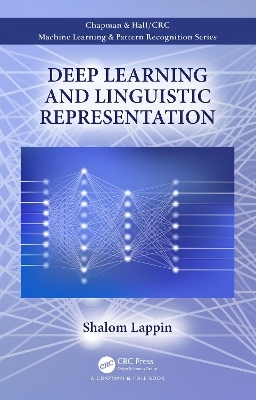
Deep Learning and Linguistic Representation
Chapman & Hall/CRC (Verlag)
978-0-367-64947-0 (ISBN)
Deep Learning and Linguistic Representation looks at the application of a variety of deep learning systems to several cognitively interesting NLP tasks. It also considers the extent to which this work illuminates our understanding of the way in which humans acquire and represent linguistic knowledge.
Key Features:
combines an introduction to deep learning in AI and NLP with current research on Deep Neural Networks in computational linguistics.
is self-contained and suitable for teaching in computer science, AI, and cognitive science courses; it does not assume extensive technical training in these areas.
provides a compact guide to work on state of the art systems that are producing a revolution across a range of difficult natural language tasks.
Shalom Lappin is Professor of Natural Language Processing at Queen Mary University of London, Professor of Computational Linguistics at the University of Gothenburg and Emeritus Professor of Computational Linguistics at King’s College London.
Chapter 1 Introduction: Deep Learning in Natural Language Processing
1.1 OUTLINE OF THE BOOK
1.2 FROM ENGINEERING TO COGNITIVE SCIENCE
1.3 ELEMENTS OF DEEP LEARNING
1.4 TYPES OF DEEP NEURAL NETWORKS
1.5 AN EXAMPLE APPLICATION
1.6 SUMMARY AND CONCLUSIONS
Chapter 2 Learning Syntactic Structure with Deep Neural Networks
2.1 SUBJECT-VERB AGREEMENT
2.2 ARCHITECTURE AND EXPERIMENTS
2.3 HIERARCHICAL STRUCTURE
2.4 TREE DNNS
2.5 SUMMARY AND CONCLUSIONS
Chapter 3 Machine Learning and The Sentence Acceptability Task
3.1 GRADIENCE IN SENTENCE ACCEPTABILITY
3.2 PREDICTING ACCEPTABILITY WITH MACHINE LEARNING MODELS
3.3 ADDING TAGS AND TREES
3.4 SUMMARY AND CONCLUSIONS
Chapter 4 Predicting Human Acceptability Judgments in Context
4.1 ACCEPTABILITY JUDGMENTS IN CONTEXT
4.2 TWO SETS OF EXPERIMENTS
4.3 THE COMPRESSION EFFECT AND DISCOURSE COHERENCE
4.4 PREDICTING ACCEPTABILITY WITH DIFFERENT DNN MODELS
4.5 SUMMARY AND CONCLUSIONS
Chapter 5 Cognitively Viable Computational Models of Linguistic Knowledge
5.1 HOW USEFUL ARE LINGUISTIC THEORIES FOR NLP APPLICATIONS?
5.2 MACHINE LEARNING MODELS VS FORMAL GRAMMAR
5.3 EXPLAINING LANGUAGE ACQUISITION
5.4 DEEP LEARNING AND DISTRIBUTIONAL SEMANTICS 1
5.5 SUMMARY AND CONCLUSIONS
Chapter 6 Conclusions and Future Work
6.1 REPRESENTING SYNTACTIC AND SEMANTIC KNOWLEDGE
6.2 DOMAIN SPECIFIC LEARNING BIASES AND LANGUAGE ACQUISITION
6.3 DIRECTIONS FOR FUTURE WORK
REFERENCES
Author Index
Subject Index
| Erscheinungsdatum | 28.04.2021 |
|---|---|
| Reihe/Serie | Chapman & Hall/CRC Machine Learning & Pattern Recognition |
| Zusatzinfo | 23 Tables, black and white; 55 Illustrations, black and white |
| Sprache | englisch |
| Maße | 156 x 234 mm |
| Gewicht | 367 g |
| Themenwelt | Geisteswissenschaften ► Philosophie |
| Geisteswissenschaften ► Sprach- / Literaturwissenschaft ► Sprachwissenschaft | |
| Informatik ► Theorie / Studium ► Künstliche Intelligenz / Robotik | |
| Technik ► Elektrotechnik / Energietechnik | |
| Technik ► Umwelttechnik / Biotechnologie | |
| ISBN-10 | 0-367-64947-0 / 0367649470 |
| ISBN-13 | 978-0-367-64947-0 / 9780367649470 |
| Zustand | Neuware |
| Haben Sie eine Frage zum Produkt? |
aus dem Bereich


